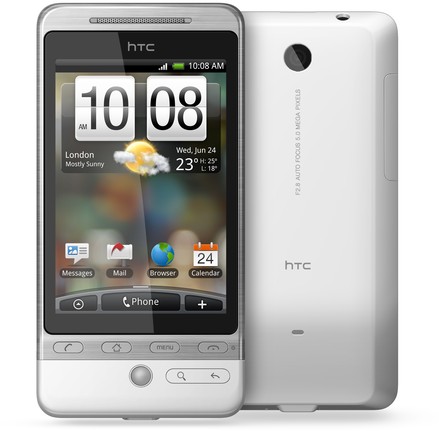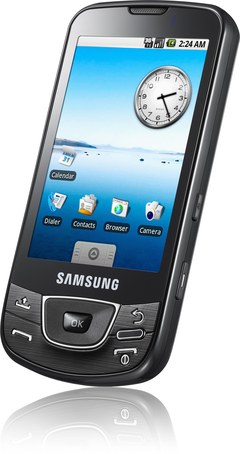
I've been wowing over these two devices approximately for the last couple of months, and decided that it's finally time to make a decision.
Both the Samsung Galaxy and the HTC Hero use the same SoC (who isn't?) - the Qualcomm MSM7200A, a 528 MHz ARM1136EJ-S core, using the ARMv6 ISA. The MSM7200 includes a 3D acceleration unit and a Qualcomm DSP, making it very suitable for any multimedia application. I do believe that the 3D acceleration unit still lacks full support under Linux/Android (much like the OMAP3530/PowerVR). Both handsets have a 5MP camera, although no secondary camera for video calling. They both have 802.11b/g, bluetooth, etc. The display on both devices is 320x480 pixels. Major differences are that the Galaxy has several more buttons (e.g. volume control), much more internal storage space, and a very power efficient AMOLED display, while the Hero sports the new Sense(R) UI, integrated Adobe Flash, more RAM, and multi-touch support.
I thought I would summarize. For those who would like to see a detailed comparison of the two devices, check out this link from pdadb.net .
| HTC Hero | Samsung Galaxy | |
|---|---|---|
| RAM (MB) | 288 | 128 |
| Flash (MB) | 512 | 7630 |
| Connector | ext-USB (mini-USB compatible) | micro-USB |
| Battery (mAh) | 1350 | 1500 |
| Display Depth | 16-bit (65-thousand colours) | 24-bit (16-million colours) |
| Display Type | Transflective TFT (standard) | AMOLED (very low power) |
| Multi-Touch? | YES! | NO! |
| Price (€) | 485,97 (Amazon.de) | 476,98 (Amazon.de) |
So far, I have not had a chance to examine either of these devices in any detail, but from what I have read, the Hero does support multi-touch. Until now, most sources have stated that the Galaxy does not support multi-touch. However, that might only be due to the fact that Android did not support multi-touch in software until the Hero came out. Perhaps the Galaxy has hardware support for multi-touch. Who knows with any certainty? I've read that the Galaxy actually has a capacitive touchscreen, so multi-touch does not seem that far off. The Galaxy also lacks Google-branding, which (aside from lacking some cover-art) means that software updates are not transferred over the air. Rather, updates must be performed manually with a USB cable, which some users might actually prefer.
Let's start with the Hero. I like that it has a large amount of RAM a great UI that supports multi-touch. The RAM will come in handy for streaming media (i.e. video) and fast context switching (Android's OOM process killer will not be called as frequently). As for multi-touch, I think you would probably agree, that there really is no alternative for pinch-zooming in the browser, or easy photo rotations. Now, the Galaxy - the fact that it's missing some RAM has been somewhat accounted for with the built-in 8GB of storage. As far as the screen goes, AMOLED spells very low-power (I love it) and still supports a true-colour (16million level) display. That will make it excellent for viewing any type of video or looking at photos. However, if the Samsung hardware truly does not support multi-touch, then I would be quite disappointed.
I have to admit, that I'm still sitting on the fence about this until I know with any certainty that the Samsung does not support multi-touch. Originally, I was thinking that the Samsung would be the best choice, without a doubt, but now I'm really considering how the extra RAM in the Hero might be beneficial. In terms of permanent storage, the Hero has more than enough, and is expandable with a micro-SD card anyway. On the other hand, the Galaxy could easily host a few operating systems on-board, or perhaps my entire collection of (decent) mp3s. This decision would definitely be easier if I knew for a fact that the Galaxy hardware did or did not support multi-touch.

4 comments:
I too went through the same dilemma albeit to a much shallower extent. Thanks for justifying my choice (post-hoc). Not that it needs justifying. The Galaxy is a beautiful piece of equipment, both hard- and software. I love the 'Home' button and the pleasant functionality of just select+hold. Try out Astrid, Pixelpipe, Tunewiki and FBReader. Great Android apps. Have fun with the Galaxy.
Did you actually make a decision?
Guys, neither of the two devices support true multi-touch like the iphone/ipodtouch do. The HTC hero has what i'd call "semi-usable dual-touch". it's good enough for the pinching gesture, but that's about it.
This kind of dualtouch is possible with those capacitive touch screens, but as soon as your two touches are either vertically or horizontally too close (touching), they're no longer precise.
You can have the same with a G1 if you "hack" the kernel. Probably also true for the samsung, tho i'm not sure about the touchscreen hardware. HTC has hacked this open to support the pinching gesture. Calling it multitouch is really an overstatement.
@Anonymous
Thanks for your input.
From what I've seen, you're right about most capacitive touchscreens really operating in 'dual-touch' mode.
Typically, these 'dual-touch' devices will have silicon inside a decoder chip to translate movements of (up to) two points into gestures, like pinch-zooming and rotation. If a gesture isn't matched, then the hardware might be able to translate that into two sets of x-y coordinates, but from what I know, Linux does not yet support multi-point mouse-selections in the event input driver.
So yeah, it's not 'true' multi-touch. However, I'm not familiar enough with the touch hardware on the iPhone or iPod-Touch to be able to state with any certainty that those use 'true' multi-touch sensors either.
In any event, I've yet to read anything convincing saying that the Galaxy has something other than a resistive (i.e. non-dual-touch) interface. In light of that, and the shortage of RAM, my pick would still be the HTC Hero.
Post a Comment